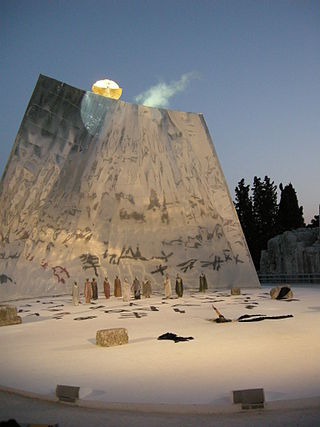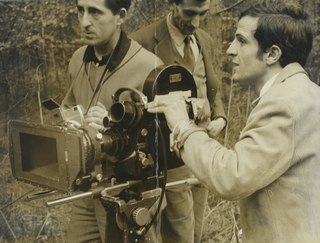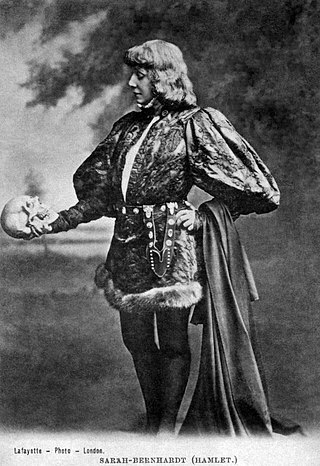
Suspension of disbelief is the avoidance—often described as willing—of critical thinking and logic in understanding something that is unreal or impossible in reality, such as something in a work of speculative fiction, in order to believe it for the sake of enjoying its narrative. Historically, the concept originates in the Greco-Roman principles of theatre, wherein the audience ignores the unreality of fiction to experience catharsis from the actions and experiences of characters. The phrase was coined and elaborated upon by the English poet and philosopher Samuel Taylor Coleridge in his 1817 work Biographia Literaria: "that willing suspension of disbelief for the moment, which constitutes poetic faith".
Alliteration is the repetition of syllable-initial consonant sounds between nearby words, or of syllable-initial vowels, if the syllables in question do not start with a consonant. It is often used as a literary device. A common example is "Peter Piper picked a peck of pickled peppers," in which the "p" sound is repeated.

A cliffhanger or cliffhanger ending is a plot device in fiction which features a main character in a precarious or difficult dilemma or confronted with a shocking revelation at the end of an episode or a film of serialized fiction. A cliffhanger is hoped to incentivize the audience to return to see how the characters resolve the dilemma.

Oedipus Rex, also known by its Greek title, Oedipus Tyrannus, or Oedipus the King, is an Athenian tragedy by Sophocles that was first performed around 429 BC. Originally, to the ancient Greeks, the title was simply Oedipus (Οἰδίπους), as it is referred to by Aristotle in the Poetics. It is thought to have been renamed Oedipus Tyrannus to distinguish it from Oedipus at Colonus, a later play by Sophocles. In antiquity, the term "tyrant" referred to a ruler with no legitimate claim to rule, but it did not necessarily have a negative connotation.

Thriller is a genre of fiction with numerous, often overlapping, subgenres, including crime, horror, and detective fiction. Thrillers are characterized and defined by the moods they elicit, giving their audiences heightened feelings of suspense, excitement, surprise, anticipation and anxiety. This genre is well suited to film and television.

A narrative, story, or tale is any account of a series of related events or experiences, whether nonfictional or fictional. Narratives can be presented through a sequence of written or spoken words, through still or moving images, or through any combination of these. The word derives from the Latin verb narrare, which is derived from the adjective gnarus. The formal and literary process of constructing a narrative—narration—is one of the four traditional rhetorical modes of discourse, along with argumentation, description, and exposition. This is a somewhat distinct usage from narration in the narrower sense of a commentary used to convey a story. Many additional narrative techniques, particularly literary ones, are used to build and enhance any given story.

Deus ex machina is a plot device whereby a seemingly unsolvable problem in a story is suddenly or abruptly resolved by an unexpected and unlikely occurrence. Its function is generally to resolve an otherwise irresolvable plot situation, to surprise the audience, to bring the tale to a happy ending or act as a comedic device.

Foreshadowing is a narrative device in which a storyteller gives an advance hint of what is to come later in the story. Foreshadowing often appears at the beginning of a story, and it helps develop or subvert the audience's expectations about upcoming events.
In literature and writing, stylistically elements are the use of any of a variety of techniques to give an auxiliary meaning, ideas, or feeling to the literalism or written.
Narrative exposition, now often simply exposition, is the insertion of background information within a story or narrative. This information can be about the setting, characters' backstories, prior plot events, historical context, etc. In literature, exposition appears in the form of expository writing embedded within the narrative.

Traditionally, conflict is a major element of narrative or dramatic structure that creates challenges in a story by adding uncertainty as to whether the goal will be achieved. In works of narrative, conflict is the challenge main characters need to solve to achieve their goals. However, narrative is not limited to a single conflict. In narrative, the term resolution refers to the closure or conclusion of the conflict, which may or may not occur by the story's end.
In contemporary literary studies, a theme is a central topic, subject, or message within a narrative. Themes can be divided into two categories: a work's thematic concept is what readers "think the work is about" and its thematic statement being "what the work says about the subject". Themes are often distinguished from premises.
Narratology is the study of narrative and narrative structure and the ways that these affect human perception. It is an anglicisation of French narratologie, coined by Tzvetan Todorov. Its theoretical lineage is traceable to Aristotle (Poetics) but modern narratology is agreed to have begun with the Russian formalists, particularly Vladimir Propp, and Mikhail Bakhtin's theories of heteroglossia, dialogism, and the chronotope first presented in The Dialogic Imagination (1975).
A scene is a dramatic part of a story, at a specific time and place, between specific characters. The term is used in both filmmaking and theatre, with some distinctions between the two.

In literature, the tone of a literary work expresses the writer's attitude toward or feelings about the subject matter and audience.
Narrative transportation theory proposes that when people lose themselves in a story, their attitudes and intentions change to reflect that story. The mental state of narrative transportation can explain the persuasive effect of stories on people, who may experience narrative transportation when certain contextual and personal preconditions are met, as Green and Brock postulate for the transportation-imagery model. As Van Laer, de Ruyter, Visconti, and Wetzels elaborate further, narrative transportation occurs whenever the story receiver experiences a feeling of entering a world evoked by the narrative because of empathy for the story characters and imagination of the story plot.
Affective disposition theory (ADT), in its simplest form, states that media and entertainment users make moral judgments about characters in a narrative which in turn affects their enjoyment of the narrative. This theory was first posited by Zillmann and Cantor (1977), and many offshoots have followed in various areas of entertainment. Entertainment users make constant judgments of a character's actions, and these judgments enable the user to determine which character they believe is the "good guy" or the "villain". However, in an article written in 2004, Raney examined the fundamental ADT assumption that viewers of drama always form their dispositions toward characters through moral judgment of motives and conduct. Raney argued that viewers/consumers of entertainment media could form positive dispositions toward characters before any moral scrutinizing occurs. He proposed that viewers sometimes develop story schemas that provide them "with the cognitive pegs upon which to hang their initial interpretations and expectations of characters". The basic idea of the affective disposition theory is used as a way to explain how emotions become part of the entertainment experience.
Meir Sternberg is an Israeli literary critic and biblical scholar. He is Artzt Professor of Poetics and Comparative Literature at Tel Aviv University. Along with Robert Alter and Adele Berlin, Sternberg is one of the most prominent practitioners of a literary approach to the Bible.

The paradox of fiction, or the paradox of emotional response to fiction, is a philosophical dilemma that questions how people can experience strong emotions to fictional things. The primary question asked is the following: How are people moved by things which do not exist? The paradox draws upon a set of three premises that seem to be true prima facie but upon closer inspection produce a contradiction. Although the emotional experience of fictional things in general has been discussed in philosophy since Plato, the paradox was first suggested by Colin Radford and Michael Weston in their 1975 paper "How Can We Be Moved by the Fate of Anna Karenina?". Since Radford and Weston's original paper, they and others have continued the discussion by giving the problem slightly differing formulations and solutions.
In literature, pace or pacing is the speed at which a story is told—not necessarily the speed at which the story takes place. It is an essential element of storytelling that plays a significant role in maintaining reader interest, building tension, and conveying the desired emotional impact. The number of words needed to write about a certain event does not depend upon how much time the event takes to happen; it depends upon how important that moment is to the story. The pace is determined by the length of the scenes, how fast the action moves, and how quickly the reader is provided with information. A well-paced story effectively balances moments of high intensity and slower-paced sections to create a dynamic reading experience. It is also sometimes dictated by the genre of the story: comedies move faster than dramas; action adventures move faster than suspense. A dragging pace is characteristic of many novels turned down by publishers, and of some that find their way into print but not into the hearts and recommendations of readers. Manuscripts that move too slowly usually discourage readers from reading on. Through various editing techniques, such as cutting unnecessary details, rearranging scenes, or suggesting additions, editors assist in maintaining an engaging pace that keeps readers captivated. Yanna Popova and Elena Cuffari elaborate that as editors they, "explore the participatory structure of a narrative through its temporal unfolding and the specific, non-linear nature of the temporal dynamics of interacting with a storytelling agency". Popova and Cuffari make clear that the way an author unfolds a story through structuring that narrative's tale is essential to the way the audience will interpret it.










